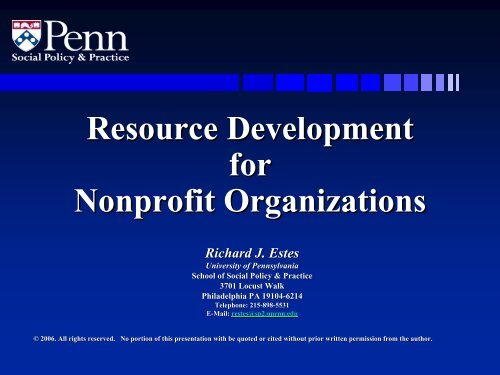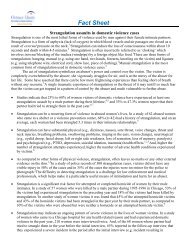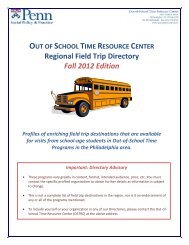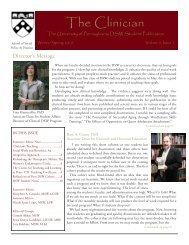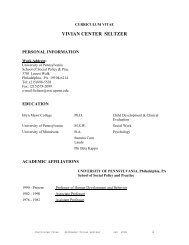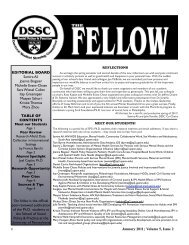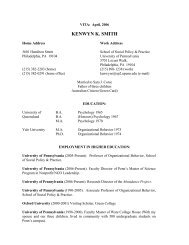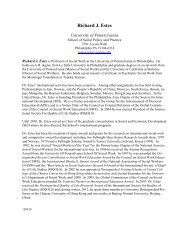fund raising - University of Pennsylvania School of Social Policy and ...
fund raising - University of Pennsylvania School of Social Policy and ...
fund raising - University of Pennsylvania School of Social Policy and ...
Create successful ePaper yourself
Turn your PDF publications into a flip-book with our unique Google optimized e-Paper software.
Resource Development<br />
for<br />
Nonpr<strong>of</strong>it Organizations<br />
Richard J. Estes<br />
<strong>University</strong> <strong>of</strong> <strong>Pennsylvania</strong><br />
<strong>School</strong> <strong>of</strong> <strong>Social</strong> <strong>Policy</strong> & Practice<br />
3701 Locust Walk<br />
Philadelphia PA 19104-6214 19104 6214<br />
Telephone: 215-898 215 898-5531 5531<br />
E-Mail: Mail: restes@sp2.upenn.edu<br />
© 2006. All rights reserved. No portion <strong>of</strong> this presentation with with<br />
be quoted or cited without prior written permission from the author.
Goals <strong>of</strong> Presentation<br />
�� Define what organizations <strong>and</strong> institutions<br />
operating in a market economy mean by “<strong>fund</strong> <strong>fund</strong><br />
<strong>raising</strong>” <strong>raising</strong><br />
�� To identify the various strategies used by<br />
charitable organizations to raise money in support<br />
<strong>of</strong> their activities<br />
�� To suggest ways in which the principles <strong>and</strong><br />
methods <strong>of</strong> <strong>fund</strong> <strong>raising</strong> could assist local<br />
PVOs/CSOs in <strong>raising</strong> money <strong>and</strong> other resources<br />
in support <strong>of</strong> their activities
What is Fund Raising?<br />
Fund <strong>raising</strong> is the process <strong>of</strong> generating resources<br />
from external sources for the purpose <strong>of</strong> carrying<br />
out a program or project <strong>of</strong> mutual interest to the<br />
donor <strong>and</strong> recipient
Basic Premises <strong>of</strong> Fund Raising<br />
�� Donors need to give, or at least are encouraged to<br />
give to charitable causes<br />
�� Charitable organizations need the financial support<br />
<strong>of</strong> individual <strong>and</strong> organizational donors<br />
�� Fund <strong>raising</strong> is the process whereby the support<br />
needs <strong>of</strong> PVOs/CSOs <strong>and</strong> the charitable<br />
preferences <strong>of</strong> donors are brought together<br />
�� Fund raisers are persons with special knowledge<br />
<strong>and</strong> skills that they use to guide the process <strong>of</strong><br />
connecting donors with recipient organizations
Two Basic Types <strong>of</strong><br />
Fund Raising<br />
�� Fund Raising for Money<br />
�� Fund Raising for contributions other than money<br />
(i.e., “in in-kind kind” contributions)
Fund Raising<br />
For Money<br />
�� Endowment <strong>and</strong> investment income (<strong>and</strong>,<br />
sometimes, subsidies)<br />
�� Project grants <strong>and</strong> contracts<br />
�� Gifts <strong>and</strong> bequests<br />
�� Sales (including fees for services provided)<br />
�� Membership dues <strong>and</strong> subscriptions<br />
�� Earnings from investment income (stocks, bonds,<br />
etc.)<br />
�� Earnings from patents, copyrights, <strong>and</strong> royalty<br />
income
Fund Raising for<br />
“In In-Kind Kind” Support<br />
�� Office space<br />
�� Utilities (e.g., heat, electricity)<br />
�� Equipment<br />
�� Furnishings (e.g., desks & chairs, computers, etc.)<br />
�� Volunteers<br />
�� Services (e.g., printing, transportation, etc.)
Sources <strong>of</strong> Funds<br />
Funds may be obtained from many sources:<br />
�� individuals<br />
�� organizations <strong>and</strong> institutions, including<br />
corporations <strong>and</strong> other businesses<br />
�� charitable foundations<br />
�� government sources , i.e., at all levels <strong>of</strong> political<br />
organization<br />
�� other sources <strong>of</strong> income
Charitable Giving, USA--2005<br />
(Total Contributions= $260.28 Billion)<br />
Individuals<br />
76.5%<br />
Source: Giving USA, 2006.<br />
Corporations<br />
5.3%<br />
Bequests<br />
6.7%<br />
Foundations<br />
11.5%
Uses <strong>of</strong> Funds Raised<br />
Depending on their source <strong>and</strong> the donor’s donor s<br />
purpose for giving, the money <strong>and</strong> “in in<br />
kind” kind contributions raised by PVOs/CSOs<br />
may be used for a variety <strong>of</strong> purposes
Uses <strong>of</strong> Charitable Giving, 2005<br />
(Total = $260.28 Billion)<br />
Public Benefit<br />
5.4%<br />
Health<br />
8.7%<br />
Arts/Cul<br />
5.2%<br />
Source: Giving USA, 2006.<br />
Education<br />
14.8%<br />
Env/Wildlife<br />
3.4% Unalloc.<br />
6.2%<br />
Religion<br />
35.8%<br />
Foundations<br />
8.3%<br />
International Affairs<br />
2.5%<br />
Human Services<br />
9.7%
The<br />
Funding<br />
“Mix Mix”
The Funding “Mix Mix”<br />
Most PVOs/CSOs look for a “mix mix” <strong>of</strong> <strong>fund</strong>ing<br />
sources, i.e., for multiple sources <strong>of</strong> support. The<br />
rationale for this is multifaceted:<br />
�� to promote community partnerships<br />
�� to reduce financial dependency on any one <strong>fund</strong>ing<br />
source<br />
�� to generate a broader base <strong>of</strong> support for<br />
organization’s organization s activities
Fund Raising<br />
Strategies<br />
Strategies are quite variable <strong>and</strong>, in the main, depend<br />
on:<br />
�� the purpose(s) for which <strong>fund</strong>s are sought<br />
�� the amount <strong>of</strong> money to be raised<br />
�� the time by which the <strong>fund</strong>s must be raised<br />
�� availability <strong>of</strong> <strong>fund</strong>ing organizations in the<br />
community<br />
�� past history <strong>of</strong> charitable giving, <strong>and</strong><br />
�� strength <strong>of</strong> contacts with potential <strong>fund</strong>ing sources
Components <strong>of</strong> the Fund<br />
Raising “Mix Mix”<br />
�� Income from fees, sales, <strong>and</strong> related activities<br />
�� Contributions from individuals (face to face<br />
solicitations, direct mail, special events, planned<br />
giving, etc.)<br />
�� grants <strong>and</strong> contracts<br />
�� gifts <strong>and</strong> bequests<br />
�� venture income
Components <strong>of</strong> the Fund<br />
Raising “Mix Mix” (continued continued)<br />
�� Contributions From Organizations<br />
– Private Sector Organizations<br />
» Foundations<br />
» Federated Fund Raising Organizations<br />
» Business Organizations<br />
» National/International PVOs/CSOs<br />
– Public Sector Organizations<br />
» Grants <strong>and</strong> Contracts (including purchase <strong>of</strong> service<br />
agreements)<br />
» Subsidies<br />
» In-kind In kind access to space, equipment, <strong>and</strong> other facilities
ORGANIZING<br />
FOR<br />
EFFECTIVE<br />
FUND RAISING
Organizing for Fund Raising:<br />
Five Preparatory Steps<br />
�� Defining a Statement <strong>of</strong> Organizational Purpose<br />
�� Building a Board <strong>of</strong> Directors<br />
�� Making an Organization Legal<br />
�� Effective Planning: Translating Ideas to Action<br />
�� Developing Budgets
Step 1:<br />
Defining Organizational Purpose<br />
Every organization must begin by identifying the<br />
central beliefs <strong>and</strong> commitments that unify its<br />
work<br />
This statement must be able to attract others to the<br />
work <strong>of</strong> the organization, e.g., members, donors,<br />
<strong>and</strong> volunteers<br />
The statement must also provide a clear<br />
underst<strong>and</strong>ing <strong>of</strong> how efforts (<strong>and</strong> money) in<br />
support <strong>of</strong> the organization will enable it to achieve<br />
the goals to which it is committed
Step 2: Building a<br />
Board <strong>of</strong> Directors<br />
People, not just ideas, make organizations successful<br />
Effective PVOs/CSOs seek to channel the energy <strong>and</strong><br />
vision <strong>of</strong> their strongest supporters through<br />
participation on the organization’s organization s Board <strong>of</strong><br />
Directors
Responsibilities <strong>of</strong> the<br />
Board <strong>of</strong> Directors<br />
�� establish policies <strong>and</strong> general procedures pertaining to the<br />
operation <strong>of</strong> all aspects <strong>of</strong> the organization<br />
�� through the person <strong>of</strong> the Executive Director, ensure the<br />
organization’s organization s compliance with the policies established by<br />
the Board<br />
�� monitor the activities <strong>of</strong> the Executive Director<br />
�� monitor the organization’s organization s effectiveness in achieving its<br />
goals<br />
�� assist in <strong>raising</strong> money<br />
�� attract new members to the Board
Criteria for Selection<br />
<strong>of</strong> Board Members<br />
Three types/clusters <strong>of</strong> persons should be recruited to serve on<br />
the Boards <strong>of</strong> PVOs/CSOs<br />
�� Persons who are most identified with the substantive<br />
commitment(s) <strong>of</strong> the organization, e.g., those with the<br />
greatest interest in the organization’s organization s success<br />
�� Persons who have program-related program related expertise in the area <strong>of</strong><br />
the PVO’s PVO operation (e.g., educators, doctors, etc.)<br />
�� Person’s Person s with specialized general expertise related to the<br />
operation <strong>of</strong> PVOs/CSOs (e.g., attorneys, accountants, <strong>fund</strong><br />
<strong>raising</strong>, etc.)
Step 3: Making<br />
an Organization Legal<br />
�� All PVOs/CSOs must operate within the context <strong>of</strong><br />
local <strong>and</strong> national laws<br />
�� Most countries have registration <strong>and</strong> licensing<br />
procedures with which PVOs/CSOs must comply<br />
�� Most countries also have rigorous auditing <strong>and</strong><br />
other public reporting requirements that<br />
PVOs/CSOs must satisfy<br />
�� PVOs/CSOs should seek to be in full compliance<br />
with the legal requirements <strong>of</strong> the public entities<br />
that oversee their activities
Step 4:<br />
Planning Your Programs<br />
Planning forces an organization to establish priorities<br />
concerning how it can best use its limited resources<br />
Planning also serves as the basis for evaluating an<br />
organization’s organization s success (or failure) in fully realizing<br />
its goals
Effective Planning<br />
�� requires a long-term long term perspective<br />
�� engages all persons who have a role in helping the<br />
organization achieve its goals<br />
�� identifies specific goals <strong>and</strong> a working timetable by<br />
which those goals are to be achieved<br />
�� contains criteria for assessing progress <strong>and</strong> a<br />
process for making necessary corrections to the<br />
plan on a timely basis
Step 5:<br />
Developing Budgets<br />
Budgeting is a program tool that enables planners to<br />
associate costs with the range <strong>of</strong> activities in which<br />
the organization will engage<br />
Budgets include two basic elements:<br />
�� Personnel Costs<br />
�� Non-Personnel Non Personnel Costs
Developing Budgets:<br />
Personnel Costs<br />
�� Staff (salaried <strong>and</strong> volunteer)<br />
�� Contracted Services (consultants, accountants,<br />
lawyers, etc.)<br />
�� Short-Term Short Term Employees (interns, work/study<br />
students)<br />
�� Fringe Benefits (health insurance, pensions,<br />
unemployment compensations, etc.)
�� Office rent<br />
�� Utilities<br />
�� Telephone<br />
�� Printing <strong>and</strong> duplication<br />
�� Office supplies<br />
�� Travel<br />
�� Liability insurance<br />
�� Membership dues<br />
�� Subscriptions <strong>and</strong> entertainment<br />
Developing Budgets:<br />
Non-Personnel Non Personnel Costs
Raising<br />
Funds<br />
From<br />
Individuals
Approaches to Raising<br />
Funds From Individuals<br />
�� Membership Dues <strong>and</strong> Subscriptions<br />
�� Face-to Face to-Face Face Solicitation<br />
�� Direct Mail<br />
�� Special Events<br />
�� “Planned Planned Giving”: Giving : Estates <strong>and</strong> Trusts<br />
�� Earned <strong>and</strong> Venture Income
Individual Giving:<br />
Membership Dues & Subs<br />
�� Membership dues (e.g., to a health or recreation<br />
facility; museum; other type <strong>of</strong> organization that<br />
invites either broad-based broad based or more specific types <strong>of</strong><br />
memberships)<br />
�� Subscriptions (e.g., season tickets to the orchestra)
Individual Giving:<br />
Face-To Face To-Face Face Solicitation<br />
Three types <strong>of</strong> face-to face to-face face solicitation:<br />
�� From persons you know directly<br />
�� From persons you “know know” through friends<br />
�� From persons you do not know, i.e., “strangers strangers”<br />
Generally, the more personal the contact, the more<br />
successful will be the solicitation
Strategies <strong>of</strong> Face-to Face to-Face Face<br />
Solicitation<br />
�� Breakfast, luncheon, <strong>and</strong> dinner meetings<br />
�� Door-to Door to-door door campaigns (e.g., Unicef <strong>and</strong> seasonal<br />
card sales)<br />
�� Telephone campaigns (e.g., Fireman’s Fireman s circus,<br />
support for environmental groups)
Individual Giving:<br />
Direct Mail<br />
A sometimes expensive but, highly effective,<br />
approach for reaching large numbers <strong>of</strong> people<br />
quickly. Requires the preparation <strong>of</strong>:<br />
�� a mailing list <strong>of</strong> prospective donors<br />
�� a cover letter<br />
�� an informational brochure<br />
�� a “pledge pledge” or gift card<br />
�� a postage-paid postage paid return envelope
Individual Giving:<br />
Special Events<br />
A specific occasion in which an NPO uses an event to:<br />
�� attract publicity<br />
�� gain new members<br />
�� educate the public<br />
�� raise money
Types <strong>of</strong> Special Event Fund<br />
Raising<br />
�� Circus<br />
�� Theatre Party or Banquet<br />
�� Concert<br />
�� Opening <strong>of</strong> a New Play, Opera, or Season<br />
�� Sports Event<br />
�� “Walkathon Walkathon”<br />
�� Auction<br />
�� Talent Night
�� Lottery<br />
�� Casino gambling<br />
�� horse/dog races<br />
�� bingo<br />
Other Types <strong>of</strong><br />
“Special Special Events” Events
Planning Tips for<br />
Special Events<br />
�� Get it donated<br />
�� Consider honoring individuals at your event<br />
�� Get volunteers to to do it<br />
�� Pick your date carefully in advance<br />
�� Make your event into an annual tradition<br />
�� Keep your events fun-filled fun filled <strong>and</strong> enjoyable<br />
�� Involve your prospective donors/participants<br />
�� Piggyback with other special events
Individual Giving:<br />
“Planned Planned Giving” Giving<br />
A highly specialized form <strong>of</strong> <strong>fund</strong> <strong>raising</strong> in which the<br />
gift or contributions are given, but for distribution<br />
at some future date-- date--<strong>of</strong>ten<br />
<strong>of</strong>ten far into the future<br />
Examples <strong>of</strong> Planned Giving:<br />
�� Life insurance<br />
�� Annuities <strong>and</strong> Trusts<br />
�� Bequests<br />
�� Gifts <strong>of</strong> Property
Individual Giving:<br />
Earned <strong>and</strong> Venture Income<br />
Two <strong>of</strong> the most intriguing, <strong>and</strong> pr<strong>of</strong>itable,<br />
approaches to <strong>raising</strong> modest-significant modest significant amounts<br />
<strong>of</strong> money in a relatively short time period<br />
Entails PVOs/CSOs engaging in a range <strong>of</strong> income<br />
<strong>and</strong> pr<strong>of</strong>it-making pr<strong>of</strong>it making activities, the proceeds <strong>of</strong> which<br />
are used to support the non-pr<strong>of</strong>it non pr<strong>of</strong>it activities <strong>of</strong> the<br />
organization
Examples <strong>of</strong> Income Earned<br />
by Non-Pr<strong>of</strong>it Non Pr<strong>of</strong>it PVOs/CSOs<br />
�� Admission fees <strong>and</strong> ticket sales<br />
�� Tuition <strong>and</strong> fees for services<br />
�� The sale <strong>of</strong> mission-related mission related goods<br />
– T-Shirts, Shirts, tote bags, bumper stickers, c<strong>of</strong>fee mugs, paper weights,<br />
etc. that bear the name or seal <strong>of</strong> the NPO<br />
– Posters that communicate a message <strong>of</strong> importance to the NPO<br />
– “Zoodoo Zoodoo” for fertilizer by “Friends Friends <strong>of</strong> the Zoo” Zoo<br />
– Books, printed programs, <strong>and</strong> other educational materials<br />
�� The sale <strong>of</strong> mission-related mission related services<br />
– The provision <strong>of</strong> security services in a high crime shopping area<br />
by an NPO that works with youth gang members<br />
– The operation <strong>of</strong> a restaurant by a cooking school
Venture Income Generated<br />
By Non-Pr<strong>of</strong>it Non Pr<strong>of</strong>it PVOs/CSOs<br />
Relates to income earned by PVOs/CSOs through the<br />
sale <strong>of</strong> goods or services that are not directly<br />
related to the mission or purpose <strong>of</strong> the<br />
organization
Examples <strong>of</strong> NPO<br />
Venture Income<br />
�� the gift shop or cafeteria operated by a museum<br />
�� a bookstore operated by a college or university<br />
�� monasteries in the US <strong>and</strong> Europe that produce<br />
wine, jams, breads <strong>and</strong> other products for sale<br />
�� rental <strong>of</strong> exhibition halls/auditorium to others for<br />
parties <strong>and</strong> special events<br />
�� greeting cards <strong>and</strong> calendars sold by many<br />
PVOs/CSOs<br />
�� trips <strong>and</strong> tours organized by the NPO<br />
�� Donation boxes left in stores <strong>and</strong> other places<br />
where large numbers <strong>of</strong> people visit
Raising<br />
Funds<br />
From<br />
Institutions
Raising Funds From Organizations:<br />
Types <strong>of</strong> Institutions<br />
�� Foundations<br />
�� Corporations <strong>and</strong> Businesses<br />
�� Government Organizations<br />
�� Religious Institutions<br />
�� Federated Fund Raising Organizations<br />
�� Associations <strong>of</strong> Individuals
Types <strong>of</strong> Support Available<br />
From Organizations<br />
�� Grants<br />
�� Contracts<br />
�� Purchase <strong>of</strong> Service Agreements<br />
�� Gifts<br />
�� Endowments<br />
�� Other (including “in in-kind kind” contributions)
Raising Funds<br />
From Foundations<br />
Requires:<br />
�� an initial letter <strong>of</strong> inquiry followed by a formal<br />
application for support in the form <strong>of</strong> a proposal<br />
�� a carefully workout budget, including a plan <strong>of</strong><br />
support after the initial <strong>fund</strong>ing from the<br />
foundation has been spent<br />
Length <strong>of</strong> time for review <strong>of</strong> application can range<br />
from a few weeks to several months to one year. In<br />
general, support is limited to a maximum <strong>of</strong> 1-3 1 3<br />
years
Foundation<br />
Type<br />
Financial Assets <strong>of</strong><br />
American Foundations, 2003<br />
Number Percent Assets<br />
($ Mil)<br />
Independent 58,991 88.8 $399,138<br />
Corporate 2,549 3.8 $ 15,447<br />
Community 699 1.1 $ 34,153<br />
Operating 4,159 6.3 $ 30,973<br />
TOTALS 66,398 100.0 $476,713
Types <strong>of</strong> Grants Awarded<br />
by Foundations<br />
�� General support grants (esp. to arts <strong>and</strong> cultural<br />
organizations)<br />
�� Program or project grants (including<br />
“demonstration<br />
demonstration” <strong>and</strong> “pilot pilot” projects)<br />
�� Capital grants (for building <strong>and</strong> large equipment<br />
purchases)<br />
�� Challenge or matching grants<br />
�� Endowment grants
% <strong>of</strong> Foundation Grants by Category, 2004<br />
(Total Grants= $15.4 Billion)<br />
Health<br />
22.3%<br />
Hum Serv<br />
13.9%<br />
Rel<br />
2.3%<br />
Soc Sci<br />
1.4%<br />
Intl<br />
2.7% Arts & Hum<br />
12.8%<br />
Sci & Tech<br />
2.9%<br />
Education<br />
23.4%<br />
Pub/Soc Ben<br />
13.0%<br />
Source: Foundation Center, 2006 (based on a national sample <strong>of</strong> 1,172 foundations awarding grants <strong>of</strong> $10,000 or more)<br />
Envir/Anim<br />
5.3%
Raising Funds From<br />
Corporations <strong>and</strong> Businesses<br />
�� Fund <strong>raising</strong> methods are quite varied <strong>and</strong> flexible<br />
�� In general, face to face solicitation on the part <strong>of</strong><br />
someone internal to the business or corporation is<br />
the most effective<br />
�� In general, businesses look for projects that:<br />
– respond to a need that impacts on the business either directly or or<br />
indirectly (e.g., educational projects that improve the human<br />
resource capacity <strong>of</strong> potential employees, opens new markets)<br />
– gives some visibility to the business’s business s support <strong>of</strong> the project<br />
– give evidence <strong>of</strong> being able to support themselves once support<br />
from the business has been withdrawn
Raising Funds From<br />
Governmental Organizations<br />
Governments provide two types <strong>of</strong> basic support for<br />
PVOs/CSOs:<br />
�� Direct Support<br />
�� Indirect Support
Types <strong>of</strong> Direct Public Support<br />
to PVOs/CSOs<br />
�� Grants (in response to formal applications <strong>and</strong><br />
proposals)<br />
�� Purchase <strong>of</strong> Service Contracts (in which the<br />
government pays to private sector to perform<br />
services that are in the “public public interest”) interest<br />
�� Subsidies, i.e., to support “public public functions” functions that<br />
are best carried out by the private sector (e.g.,<br />
family planning services, arts <strong>and</strong> culture, etc.)
Types <strong>of</strong> Indirect Public<br />
Support to PVOs/CSOs<br />
�� Tax exemptions<br />
�� Reduced mail rates<br />
�� Public employee charitable solicitations<br />
�� Support for revenue-generating revenue generating programs (e.g., tax<br />
free <strong>fund</strong> <strong>raising</strong> from gambling, canvassing, etc.)<br />
�� Access to public forums for debate (e.g., legislative<br />
<strong>and</strong> commission hearings, public television <strong>and</strong><br />
radio, etc. are open to PVOs/CSOs for speaking out<br />
on issues <strong>of</strong> concern to them)
Raising Funds From Religious<br />
Organizations<br />
Fund <strong>raising</strong> purposes must be consistent with the<br />
religious nature <strong>and</strong> purpose <strong>of</strong> the <strong>fund</strong>ing<br />
organization<br />
Often, support is limited to “in in kind” kind services (space<br />
<strong>and</strong> access to equipment) <strong>and</strong> volunteer support,<br />
although larger religious organizations are able to<br />
contribute cash as well
Raising Funds Through<br />
“Federated Federated Fund Raising” Raising<br />
�� Often referred to as the “United United Way” Way<br />
�� Involves joint <strong>fund</strong> <strong>raising</strong> on the part <strong>of</strong> several or<br />
many organizations working together<br />
�� appeals for support are limited to designated time<br />
intervals during the year <strong>and</strong> to specifically<br />
targeted audiences:<br />
– individual contributors<br />
– employers <strong>and</strong> business organizations<br />
– workers unions <strong>and</strong> organizations<br />
– other associations <strong>of</strong> individuals
United Way <strong>of</strong> America, 2005<br />
United Way <strong>of</strong> America, 2006<br />
(Total Contributions= $74,225 Million)<br />
Individuals<br />
19.0%<br />
Employees<br />
54.0%<br />
Corporations<br />
24.7%<br />
Com & Fam Fdns<br />
2.3%
United Way <strong>of</strong> America--Uses, 2005<br />
Program Services<br />
61.5%<br />
Source: United Way <strong>of</strong> America, 2006<br />
(Total = $74,225,000)<br />
Net Assets Retained<br />
30.2%<br />
Supporting Services<br />
8.3%
General Structure <strong>of</strong><br />
Federated FR Organizations<br />
A membership organization consisting <strong>of</strong> local<br />
organizations engaged in charitable works or other<br />
activities that service the “public public good.” good.<br />
The federation is governed by a Board <strong>of</strong> Directors whose<br />
members include:<br />
�� major donors (especially large employer organizations)<br />
�� representative <strong>of</strong> member organizations<br />
�� representatives <strong>of</strong> the general public<br />
�� representatives <strong>of</strong> persons served by federation members, i.e.,<br />
clients/consumers <strong>of</strong> services<br />
�� others with special expertise/interest in the work <strong>of</strong> the federation federation
Financial Advantages <strong>of</strong><br />
Federated Fund Raising<br />
�� Reliable source <strong>of</strong> steady income<br />
�� Savings in your own <strong>fund</strong><strong>raising</strong> time <strong>and</strong> budget<br />
�� Heightened public pr<strong>of</strong>ile<br />
�� Enhanced reputation<br />
�� Networking <strong>and</strong> technical assistance (including<br />
worker <strong>and</strong> volunteer training/education)
Raising Funds From Associations<br />
<strong>of</strong> Individuals<br />
�� All <strong>of</strong> us belong to various types <strong>of</strong> organizations<br />
that are willing to assist PVOs/CSOs in <strong>raising</strong><br />
money to support projects or programs <strong>of</strong> mutual<br />
interest (e.g., unions, civic organizations, religious<br />
organizations, self help/mutual aid societies <strong>and</strong><br />
groups, etc.)<br />
�� Associations are a rich source <strong>of</strong> volunteer support<br />
(esp. for work with individuals <strong>and</strong> as workers in<br />
special event <strong>fund</strong> <strong>raising</strong> efforts)
Other Types <strong>of</strong><br />
Income:<br />
�� Patent, Copyright, <strong>and</strong> Royalty Income<br />
�� For larger institutions, these sources <strong>of</strong> income can<br />
be quite substantial, e.g., universities, research<br />
institutes, <strong>and</strong> other institutions engaged in<br />
research or the development <strong>of</strong> protected<br />
inventions
Fund Raising<br />
From Institutions:<br />
The Elements <strong>of</strong><br />
Proposal Writing
Elements <strong>of</strong><br />
Proposal Writing<br />
�� Title Page<br />
�� Abstract<br />
�� Statement <strong>of</strong> Need/Problem<br />
�� Statement <strong>of</strong> Goals & Objectives<br />
�� Implementation Procedures<br />
�� Evaluation<br />
�� Dissemination<br />
�� Facilities <strong>and</strong> Equipment<br />
�� Personnel<br />
�� Budget
Proposal Elements:<br />
Title Page<br />
Must include all <strong>of</strong> the following elements:<br />
– title <strong>of</strong> project<br />
– name <strong>of</strong> applicant organization<br />
– name <strong>of</strong> organization from which <strong>fund</strong>s are<br />
being requested<br />
– inclusive dates <strong>of</strong> project<br />
– total project budget<br />
– signatures <strong>of</strong> authorized personnel approving<br />
submission <strong>of</strong> proposal to <strong>fund</strong>ing organization
Characterized by the following elements:<br />
Proposal Elements:<br />
Abstract<br />
– limited to a maximum <strong>of</strong> 250-500 250 500 words<br />
– contains a summary <strong>of</strong> the major elements <strong>of</strong> the project with<br />
reference to:<br />
» the statement <strong>of</strong> need<br />
» project objectives<br />
» project procedures<br />
» project evaluation plan<br />
» plans for dissemination <strong>of</strong> findings<br />
– should stress the end products that will result from the project<br />
(e.g., new approaches to service delivery, construction <strong>of</strong> a new<br />
or improved facility, development <strong>of</strong> a new <strong>fund</strong>ing<br />
arrangement, etc.)
Proposal Elements:<br />
Problem/Need Statement<br />
�� Must contain a clear explanation <strong>of</strong> the need for<br />
the project including:<br />
– numbers <strong>of</strong> people affected by the problem or concern<br />
– how the need has changed over time<br />
– prospects for the future should the proposed project not be<br />
implemented<br />
�� As possible, include statistical <strong>and</strong> graphical data<br />
to illustrate the nature <strong>of</strong> the changing need over<br />
time<br />
�� Overall, the ability <strong>of</strong> the project to respond to the<br />
identified need should be stressed
Example <strong>of</strong> Need<br />
To provide alternative learning<br />
opportunities for students who do<br />
not benefit from the regular<br />
mathematics program
Project goals <strong>and</strong> objectives must: must:<br />
Proposal Elements:<br />
Goals <strong>and</strong> Objectives<br />
– flow logically from the identified needs or<br />
problems<br />
– be responsive to the identified needs or<br />
problems<br />
– be consistent with the mission <strong>and</strong> purpose <strong>of</strong><br />
the NPO<br />
– be measurable such that progress (or failure)<br />
toward their realization can be assessed
�� Goal:<br />
Example <strong>of</strong> Goal(s)<br />
<strong>and</strong> Objective(s<br />
– to assist selected high school students acquire independent<br />
study skills in mathematics<br />
�� Objective:<br />
– Forty students selected from the 10th grade will be able to<br />
demonstrate newly acquired independent study skills by<br />
successfully completing a test on a major aspect <strong>of</strong> the<br />
mathematics curriculum every two months<br />
– Success will be determined by the students achieving a<br />
score <strong>of</strong> 80 percent or more on the test<br />
– The test will be devised by an independent consultant
Project methods must: must<br />
Proposal Elements:<br />
Implementation Procedures<br />
– be specific, reasonable, <strong>and</strong> appropriate to the<br />
proposed project<br />
– identify program participants, other<br />
organizations to be involved in the project, <strong>and</strong><br />
time lines by which certain tasks are to be<br />
achieved<br />
– make efficient ($) <strong>and</strong> effective use <strong>of</strong> project<br />
resources
Example <strong>of</strong> Implementation<br />
Procedures<br />
�� A mathematics teacher will provide one hour <strong>of</strong><br />
orientation instruction each week, pointing out the<br />
major areas <strong>of</strong> information to be covered<br />
�� Supplementary reading material will be distributed<br />
following each session<br />
�� Students will also be given a set <strong>of</strong> self-tests self tests for<br />
each curriculum component<br />
�� A tutor will be available during the week to answer<br />
questions
Proposal Elements:<br />
Evaluation<br />
�� Systematic project evaluation is <strong>of</strong> increasing<br />
importance to <strong>fund</strong>ing agencies. In general, the<br />
concern is with:<br />
– the extent to which the project achieves the goals <strong>and</strong> objectives objectives<br />
for which <strong>fund</strong>ing was provided (i.e., project “effectiveness<br />
effectiveness”)<br />
– makes efficient use <strong>of</strong> those resources, i.e., achieves the “biggest biggest<br />
bang” bang for the fewest dollars <strong>of</strong> investment<br />
�� Also involves:<br />
– creation <strong>of</strong> evaluation tools (e.g., questionnaires <strong>and</strong><br />
st<strong>and</strong>ardized instruments)<br />
– systematic data collection <strong>and</strong> analysis (including cost/benefit<br />
analysis when possible)
Example <strong>of</strong><br />
Evaluation Section<br />
�� A mathematics teacher will administer the test<br />
every two months, grade the exam, <strong>and</strong> report the<br />
results to the project director<br />
�� The director <strong>and</strong> an independent study consultant<br />
will meet with each student to discuss his or her<br />
test results <strong>and</strong> assist in designing additional<br />
independent study to remedy any deficiencies
Proposal Elements:<br />
Dissemination<br />
�� Funding sources are interested in organizations<br />
sharing the results <strong>of</strong> their project experiences <strong>and</strong><br />
findings with others<br />
�� As possible, plan to report the results <strong>of</strong> your work<br />
through:<br />
�� presentation <strong>of</strong> your findings at local, regional,<br />
national, <strong>and</strong> international meetings<br />
�� as appropriate, publication <strong>of</strong> your experiences in<br />
appropriate outlets (e.g., newspaper stories,<br />
pr<strong>of</strong>essional journals, etc.)
Proposal Elements:<br />
Facilities <strong>and</strong> Equipment<br />
This section should identify the location <strong>and</strong><br />
adequacy <strong>of</strong> the facilities <strong>and</strong> equipment required<br />
to implement the project<br />
If new or additional facilities/equipment is needed,<br />
then, the project should explain how/where these<br />
resources will be generated
Proposal Elements:<br />
Personnel<br />
One <strong>of</strong> the most sensitive elements <strong>of</strong> the proposal,<br />
the writers must identify: identify<br />
– the number, type, educational level, experiential<br />
backgrounds, <strong>and</strong> other criteria <strong>of</strong> persons needed to<br />
implement the project<br />
– consultants to be engaged by the project<br />
– the supervisory structure for managing the work <strong>of</strong><br />
project personnel<br />
– the relationship <strong>of</strong> project personnel to other<br />
personnel employed by the recipient organization
Proposal Elements:<br />
Budget<br />
�� The project budget must provide detailed cost<br />
information for all <strong>of</strong> the following:<br />
�� Personnel (including the cost <strong>of</strong> fringe benefits)<br />
�� Consultants<br />
�� Travel<br />
�� Supplies <strong>and</strong> Materials<br />
�� Utilities (e.g., phone, electricity, fax, etc.)<br />
�� Data Processing<br />
�� Facilities <strong>and</strong> Equipment<br />
�� Indirect Costs, i.e., overhead, or costs that cannot be directly<br />
billed to the project (e.g., utilities, library, maintenance <strong>of</strong><br />
grounds or concert hall, etc.)
Seminar on Fund Raising<br />
The<br />
End


